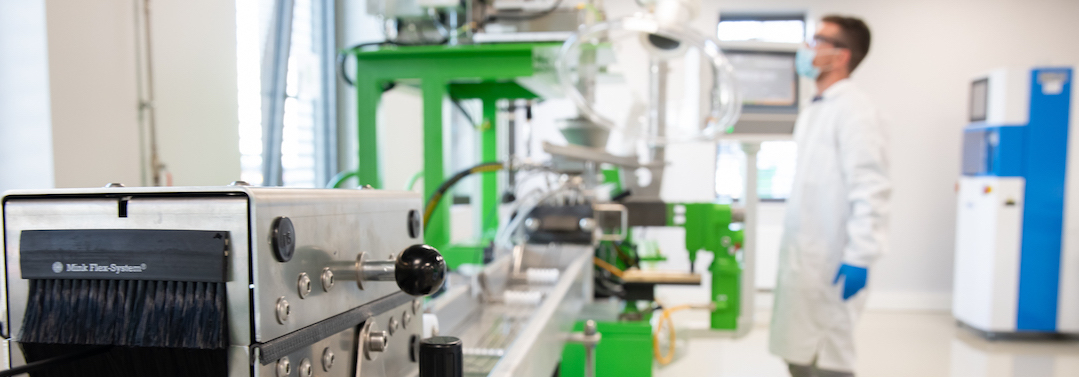Nanotube technologies for thermosets in TUBALL CENTER Luxembourg
In September 2020, OCSiAl launched its TUBALL Center in Luxembourg with a focus on graphene nanotube technologies for various thermoplastics, rubbers, and thermosets. The goal set for the Center is to conduct research & development of materials with a new set of properties for the cars of the future, along with a further increase in the quality and speed of European customer support services.

The Center has two floors with zones dedicated to compounding, testing, and chemical labs. In total, it covers 300 m2 with more than 30 testing devices.
Today Vladimir Kravchenko, OCSiAl Group Development and Support Leader for Thermosets, will share information on the capabilities of the thermosets division, the methods applied, and the processing and testing equipment available at the TUBALL Center in Luxembourg.

1. What share do thermoset solutions hold among TUBALL Center Luxembourg’s projects?
TUBALL Center Luxembourg (TCL) was designed to provide technical support to European clients, and to develop new products for different polymers and applications: thermoplastics, thermoset coatings and composites, and various elastomers. After almost one year of operational activity of TCL, the thermoset projects could be highlighted as the most frequently requested in terms of technical support. But the difference compared to other applications is not significant.
2. Thermosets is a huge group of materials. Could you specify the systems that you’ve been working with?
As the main focus, we work with coating cases mainly related to epoxy, acrylic, and polyurethanes. This can be solvent-based or solvent-free systems, of course, as well as filled and unfilled systems with various types of dispersing, colorful, leveling, thixotropic, or other agents and fillers. Almost every case has a complex formulation, and special application equipment and conditions. To meet the high requirements of the end customers, all these parameters should be determined in each particular case.
Secondly, I would mention composites based on epoxy, vinyl ester, and polyester systems. Generally, this is in glass or carbon fiber-based composites produced via filament winding, pultrusion, SMC/BMC, hand layup and other technologies.
We also work on polymer systems, such as phenolic, melamine, and others. Such materials choices can be determined, as always, by the cost-to-performance ratio and final customer requirements for each application.
3. What are your capabilities in terms of equipment? Is it industry-standard equipment or some specific equipment for nanomaterials?
This is one of our main principles, that TUBALL based products such as concentrate or suspensions must be dispersed and used via standard, widely available industrial equipment. This approach significantly simplifies the implementation of TUBALLTM nanotubes for our partners: they spend less time and internal resources.
For thermoset applications, the equipment includes high-speed mixers or dissolvers with special types of impeller blades for the recommended dilution, standard degaussing equipment sets, and various coating applicators. For quality control, it includes everything related to optical microscopy, electrical resistivity measurements, Brookfield viscosimeters, and grindometers to assess particle size.
Of course, this is not the full list, but one of the most frequently used and requested equipment. For our partners, we have prepared a special document describing our list of equipment and methods available in TCL for thermosets.
4. Could you please describe of your division’s typical projects?
I would say, there are few groups or types of typical requests:
- Define the most appropriate type and dosage of TUBALLTM-based products and relevant mixing conditions for a specific system;
- Optimize the formulation modified with TUBALLTM nanotubes to meet a complex request;
- Prepare a tailor-made TUBALLTM-filled masterbatch for a specific request;
- Evaluate the final performance and various properties of already cured coatings or composites modified with TUBALLTM and shipped from our partners to TCL.
The final group is the most often requested. I would say, more than 30–35% of all resources are spent on these requests. In my opinion, it is related to the availability of high-quality equipment in TCL, especially for the electrical resistance measurements.
5. What was the most challenging goal given to you in the last year? Was it a customer case or product development?
Almost all our projects, as well as the particular related technical details, are covered by NDAs. And OCSiAl respects partnership conditions.
From the list of projects that can be shared and discussed, one of the most challenging was to design a new TUBALL-based product for vinyl ester resin. The project is still ongoing. The new development will be beneficial for various composite applications, such as GRP pipes, tanks, rebars, and some types of SMC composites. For further details and new product presentations, you can subscribe to our YouTube channel or follow our LinkedIn page.
If you are interested in any joint projects with the OCSiAl team, or would like to learn more, contact Hendrik Janssen, Technical Support Lead for Europe, at Hendrik.janssen@ocsial.com or via the contact form at tuball.com.